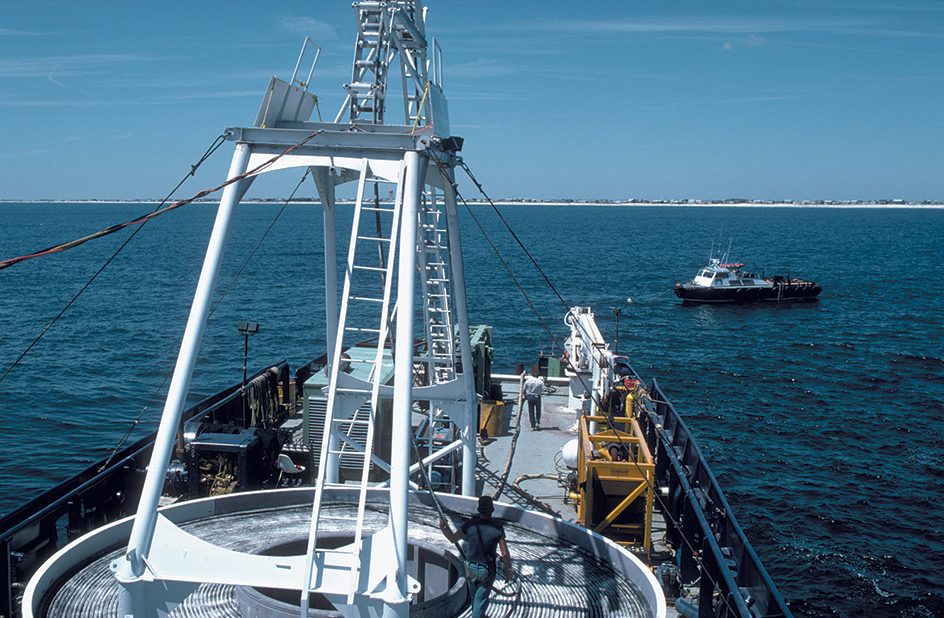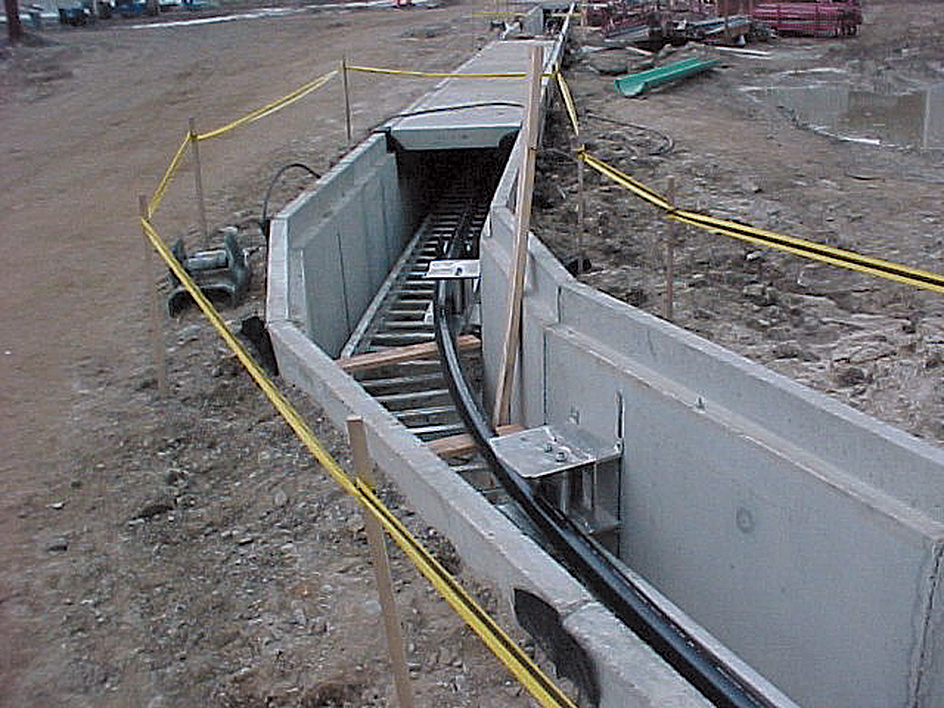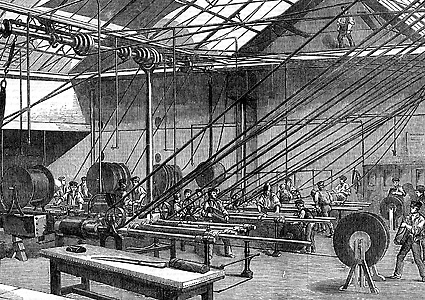Cable, for electric and communications use, is an insulated wire or bundle of wires that carry electric current or a bundle of glass fibers that carry pulses of light. Cables link many kinds of electronic devices together, including television screens, stereos, loudspeakers, and video game systems. In addition, billions of miles of cable carry Internet, telephone, and television signals and electric power throughout the world. The terms cable and wire are sometimes used interchangeably.
Many devices, such as cell phones and tablet computers, transmit signals using radio waves instead of with cables. In many cases, however, cables still provide the fastest means of transmitting communications signals.
Types of cables
Cables can be divided into two basic types: (1) electrical cables and (2) fiber-optic cables. Electrical cables are made of conductors (materials capable of carrying electric current). Such cables may carry an electronic signal in the form of a pattern of electric current. They can also transmit electric power. Fiber-optic cables, on the other hand, do not conduct electric current. They are made of extremely tiny glass or plastic threads that transmit signals using pulses of laser light. Both types of cables are covered with protective material to prevent signal loss or interference.

Electrical cables
are most commonly made of copper, which conducts electricity well and does not corrode easily. Some cables are made of aluminum. Aluminum is a less ideal conductor than is copper, but aluminum is lighter and less expensive. Conductors of small diameter, such cables used inside computers, carry low-voltage, low-amperage electric currents. Large-diameter conductors, such as those used in electric power transmission, carry high-voltage, high-amperage currents.
Insulation prevents electric current from escaping the conductor. It also protects the conductor from damage and helps prevent interference. Interference occurs when a conductor picks up electric signals from other nearby conductors or from the air. The most common insulation materials are plastics. However, some electric power cables are insulated using paper saturated with oil. Cable used for long-distance electric power transmission often has insulation more than 1 inch (25 millimeters) thick.
Simple cables consist of a single pair of insulated wires twisted together. Multiconductor cables have three or more insulated conductors. Some multiconductor cables used in communications, such as telephone lines, can contain hundreds or even thousands of insulated conductors bound together. Multiconductor cables are usually enclosed in a heavy sheath made of several layers of aluminum or plastic. Some thick cables also incorporate steel wire to provide strength.
Coaxial cables are made up of two conductors, one surrounding the other. The outer conductor is a rigid or flexible metal tube, and the inner conductor is a wire running through the tube’s center. Insulation holds the wire in place and separates the two conductors. The cables are called coaxial because the tube and the wire have the same axis (center). A typical coaxial cable has about the same diameter as a pencil. Several such cables may be bundled together.
Coaxial cables can carry many telephone conversations, television stations, or Internet signals at once. Individual signals do not interfere with each other because they are carried by electric currents oscillating (moving back and forth) at different frequencies (numbers of cycles per second).
Most cables used to transmit or distribute electric power are also coaxial cables. The inner conductor carries the electric current. The outer conductor is connected to a neutral ground point in the system to maintain a uniform electric field on the cable surface and to prevent electric shocks.
Coaxial electric power cables are made with great care. The insulation of these cables must hold in high levels of electric power. Contamination, such as small metal particles in the insulation, can result in electrical stresses that will cause the cable to eventually fail.
Fiber-optic cables,
also called optical cables, carry signals in the form of light. Such cables consist of a bundle of threadlike transparent glass or plastic optical fibers. Signals coded as pulses of light are sent into one end of an optical fiber by a laser, and the light travels through the core. Cladding, a thin covering usually made of glass, surrounds the core of each fiber and helps prevent the light from escaping. A photosensitive device at the other end of the fiber receives the coded signals, which another device then converts to the original signals.
Fiber-optic cables form the core of many Internet and other communication networks. They can transmit much more data per second than can copper electrical cables. No electrical interference occurs in fiber-optic cables, and there is less signal loss (gradual weakening of signals as they travel along a cable) than there is in electrical cables.
Cable installation
Cables can be laid underground or along the ocean floor, or they can be mounted on poles. Underground cables can be laid directly in the earth or they can be pulled through conduits. Conduits are pipes or tubes that are laid in the ground and then covered before the cable is installed. Burying cable protects it from harsh weather and keeps the land surface uncluttered. As a result, few new cables are strung aboveground. Underwater communications cables serve as a link between continents. Special amplifiers installed at various points along a cable system strengthen signals to prevent signal loss.

During installation, it is often necessary to splice (connect) two cables together. Fiber-optic and high-energy electric power cables are spliced in specially constructed temporary rooms with filtered, extra-clean air.

History
Telegraph cables.
In 1844, the American painter and inventor Samuel F. B. Morse completed the first long-distance telegraph cable in the United States. The cable extended from Baltimore to Washington, D.C. It was strung on wooden poles and insulated with glass plates.
During the late 1840’s, numerous attempts were made to lay telegraph cables along the bottom of various bodies of water. Many of these attempts failed because the insulation on the cables could not shield the conductors from the water. In 1851, two English brothers, Jacob and John Brett, succeeded in laying a telegraph cable across the English Channel. In making their cable, they used a tough insulation consisting of a fiber called hemp and a rubberlike substance called gutta-percha. They also used iron to strengthen their cable.
The Atlantic Telegraph Company, organized by the American businessman Cyrus W. Field, laid the first telegraph cables across the bottom of the Atlantic Ocean. From 1857 to 1866, the company made four attempts to lay a transatlantic cable, but the cables either broke while being laid or failed after a short time. Success finally came in 1866, when the British steamship Great Eastern laid a cable from Valentia, Ireland, to Heart’s Content, on the Canadian island of Newfoundland. Much of the success of the transatlantic cable was due to the work of the British physicist William Thomson (later Lord Kelvin), who supervised the project. By 1900, 15 transatlantic telegraph cables were in operation.

Electric power cables.
In mid-1880, Thomas Edison planned the installation of his first incandescent-lighting system in New York. Because the system’s cables would encompass all the individual wires leading to houses, they would be too large to suspend from poles. Edison determined that they would have to be buried. He initially thought wood would serve as a good insulator for his cables, and so he performed tests using wires laid in wood moldings in shallow trenches. However, Edison soon found that wood lost its insulating properties when it became wet. He tried various other insulating materials, eventually settling on asphalt mixed with linseed oil and small amounts of paraffin and beeswax. This compound was heated, and then strips of muslin were dipped into it and wrapped around the conductors. This method worked, and by the end of November 1880, Edison’s new system was lighting 400 street lamps.
Telephone cables.
The Scottish-born inventor Alexander Graham Bell patented the telephone in 1876. Thousands of telephones quickly came into use, and many cities became cluttered with telephone lines consisting of single insulated wires. In the late 1880’s, engineers found that, by twisting wires together, they could produce a stronger cable and limit the clutter. The first underground telephone cable was installed in 1902 between New York City and Newark, New Jersey.
In 1931, two American engineers, Lloyd Espenschied and Herman A. Affel, patented the coaxial cable. Coaxial cables were first used commercially in 1941.
The laying of the first transatlantic telephone cable was completed in 1956. This cable extended from Clarenville, on Newfoundland, to Oban, Scotland. The first long-distance fiber-optic cable was completed in 1983. It carries telephone conversations between New York City and Washington, D.C. The first fiber-optic cables to span the Atlantic and Pacific oceans joined the United States with France and the United Kingdom in 1988 and the United States with Japan in 1989.
Recent developments.
In the 2000’s and 2010’s, broadband Internet connections using high-speed cables became common around the world. But connecting high-speed cables to remote, rural areas remained challenging for many countries.
Some newer electric power cables make use of optical fibers to provide information about the cable’s performance and soundness. Advances in technology have led to the development of highly efficient superconducting cables that can carry vast amounts of electric power. Superconductors are conductors that have almost no resistance to the flow of electric current. Superconducting cables are made from special ceramic fibers that become superconducting when cooled with liquid nitrogen. Electric utilities have begun to test this type of cable for use in large cities that lack space for new power lines.
